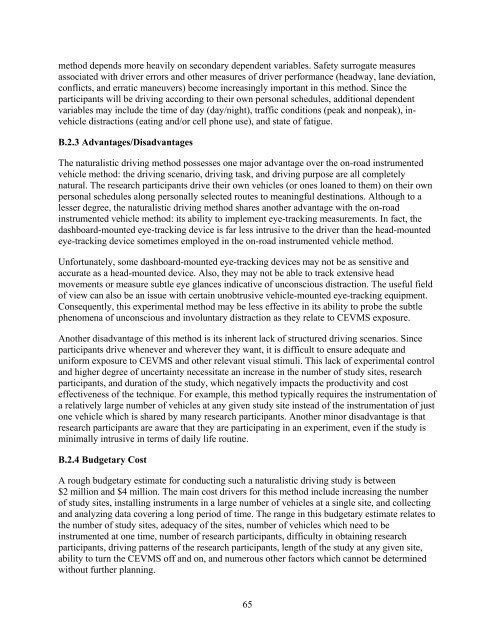The Effects of Commercial Electronic Variable Message Signs ...
The Effects of Commercial Electronic Variable Message Signs ...
The Effects of Commercial Electronic Variable Message Signs ...
You also want an ePaper? Increase the reach of your titles
YUMPU automatically turns print PDFs into web optimized ePapers that Google loves.
method depends more heavily on secondary dependent variables. Safety surrogate measures<br />
associated with driver errors and other measures <strong>of</strong> driver performance (headway, lane deviation,<br />
conflicts, and erratic maneuvers) become increasingly important in this method. Since the<br />
participants will be driving according to their own personal schedules, additional dependent<br />
variables may include the time <strong>of</strong> day (day/night), traffic conditions (peak and nonpeak), invehicle<br />
distractions (eating and/or cell phone use), and state <strong>of</strong> fatigue.<br />
B.2.3 Advantages/Disadvantages<br />
<strong>The</strong> naturalistic driving method possesses one major advantage over the on-road instrumented<br />
vehicle method: the driving scenario, driving task, and driving purpose are all completely<br />
natural. <strong>The</strong> research participants drive their own vehicles (or ones loaned to them) on their own<br />
personal schedules along personally selected routes to meaningful destinations. Although to a<br />
lesser degree, the naturalistic driving method shares another advantage with the on-road<br />
instrumented vehicle method: its ability to implement eye-tracking measurements. In fact, the<br />
dashboard-mounted eye-tracking device is far less intrusive to the driver than the head-mounted<br />
eye-tracking device sometimes employed in the on-road instrumented vehicle method.<br />
Unfortunately, some dashboard-mounted eye-tracking devices may not be as sensitive and<br />
accurate as a head-mounted device. Also, they may not be able to track extensive head<br />
movements or measure subtle eye glances indicative <strong>of</strong> unconscious distraction. <strong>The</strong> useful field<br />
<strong>of</strong> view can also be an issue with certain unobtrusive vehicle-mounted eye-tracking equipment.<br />
Consequently, this experimental method may be less effective in its ability to probe the subtle<br />
phenomena <strong>of</strong> unconscious and involuntary distraction as they relate to CEVMS exposure.<br />
Another disadvantage <strong>of</strong> this method is its inherent lack <strong>of</strong> structured driving scenarios. Since<br />
participants drive whenever and wherever they want, it is difficult to ensure adequate and<br />
uniform exposure to CEVMS and other relevant visual stimuli. This lack <strong>of</strong> experimental control<br />
and higher degree <strong>of</strong> uncertainty necessitate an increase in the number <strong>of</strong> study sites, research<br />
participants, and duration <strong>of</strong> the study, which negatively impacts the productivity and cost<br />
effectiveness <strong>of</strong> the technique. For example, this method typically requires the instrumentation <strong>of</strong><br />
a relatively large number <strong>of</strong> vehicles at any given study site instead <strong>of</strong> the instrumentation <strong>of</strong> just<br />
one vehicle which is shared by many research participants. Another minor disadvantage is that<br />
research participants are aware that they are participating in an experiment, even if the study is<br />
minimally intrusive in terms <strong>of</strong> daily life routine.<br />
B.2.4 Budgetary Cost<br />
A rough budgetary estimate for conducting such a naturalistic driving study is between<br />
$2 million and $4 million. <strong>The</strong> main cost drivers for this method include increasing the number<br />
<strong>of</strong> study sites, installing instruments in a large number <strong>of</strong> vehicles at a single site, and collecting<br />
and analyzing data covering a long period <strong>of</strong> time. <strong>The</strong> range in this budgetary estimate relates to<br />
the number <strong>of</strong> study sites, adequacy <strong>of</strong> the sites, number <strong>of</strong> vehicles which need to be<br />
instrumented at one time, number <strong>of</strong> research participants, difficulty in obtaining research<br />
participants, driving patterns <strong>of</strong> the research participants, length <strong>of</strong> the study at any given site,<br />
ability to turn the CEVMS <strong>of</strong>f and on, and numerous other factors which cannot be determined<br />
without further planning.<br />
65

















